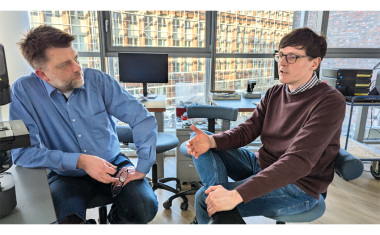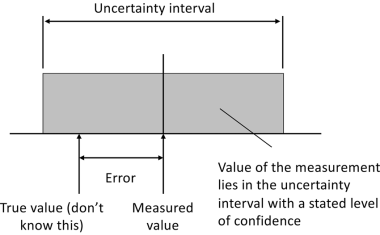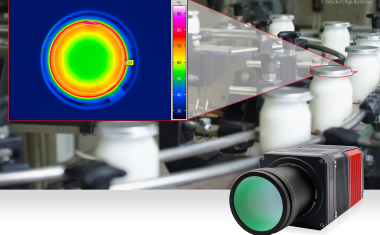Unique Flow Cytometer with Huge Dynamic Range
The essence of flow cytometry, a widely used method in research and clinical laboratory applications, is fast analysis (and sometimes sorting) of huge amounts of individual cells. As particles are streamed through a flow cell one-by-one, they pass one or more focused laser beams. The fluorescence and scattered laser light they emit are detected by photomultiplier tubes via bandpass and cut-off filters, and their correlated signals are used to count and classify the particles. The fluorescence can be due to fluorochromes attached to the particles and/or it can be natural autofluorescence. The majority of instruments are optimized for particles in the 1 – 50 micron size range, e.g., for human blood cells or other mammalian cells. However, there are a number of applications that need the capability of counting much larger particles such as ecology studies of sea water, developing algae as a source of biofuels, and assessing water content and quality for fish and shrimp farms. Moreover, some applications ideally need the shape of particles to be measured as they are counted in real time: both larger particles like phytoplankton and “unusual” particles, like checking the shape of sperm cells from rare breeds of farm animals and studies of filamentous fungi. Yet other applications require the ability to detect and count smaller structures (e.g., organelles) inside these particles.
George Dubelaar, CEO of CytoBuoy b.v. (Woerden, Netherlands) explains, “Our instruments all derive from design principles originally established with the Optical Plankton Analyzer (OPA), a big flow cytometer we developed for Amsterdam University almost 30 years ago, such as the large 1 mm2 flow cell. Still aiming at natural plankton assemblages containing cells from small to large, up to fragile colonies and filaments, our CytoSense instruments today are 1 ft3, portable and offer a unique combination of advantages. They combine a huge dynamic range – from extremely small (100 nm beads) up to particles as large as 2 x 0.8 mm – with high speed scanning. Unlike typical cytometers that sum the entire signal from each PMT for each particle, the CytoSense instrument captures real-time pulse profiles. Each detector signal is digitized at 4 MHz or each 0.5 um of a particle flowing at 2 m/s through the sharp laser focus. For example, a nine detector CytoSense produces nine correlated profiles of 2000 data points for a single 1 mm long filamentous particle. Except for small single cells, these fluorescence and scatter profiles represent useful morphological information of the overall particle shape as well as the number and distribution of smaller fluorescent entities within a particle – see figure 1.
Compact and Seaworthy
More phytoplankton is located in the sea than anywhere else, so that’s also where many applications for phytoplankton counting are to be found. Continuous measurements and remote (sub-surface) applications are best supported by an instrument that can be deployed and automatically operated remotely in seawater. For this reason, the company offers a watertight floating instrument, appropriately called CytoBuoy – see figure 2 – that is equipped with solar panels for extended remote operation, and a submersible called CytoSub – see figure 3 – that is encased in a pressure-resistant housing enabling it to be lowered to a depth of 200 meters. Dubelaar explains, “In every case, our in situ products are based on the same measurement engine found in our benchtop laboratory products. In addition to a water-tight enclosure, these instruments all feature miniaturization of the optics, fluidics and electronics, minimized power budgets, and stable long-lived components and robust instrument construction.”
Laser Sources
Arguably, the most critical components in any flow cytometer are the laser(s) themselves. CytoBuoy recently upgraded their common CytoSense instrument platform (see figure 4) by incorporating the latest generation of smart, plug & play lasers from the Coherent OBIS series, in which the laser cavity and all control electronics are contained in a single, compact package. Moreover, the electronic interface and opto-mechanical configuration is standardized across all models within the product line. This simplifies laser integration, output power upgrades, and wavelength additions to multi-laser instruments. These continuous wave lasers are available at a range of wavelengths spanning the near UV through the red (375 nm – 785 nm), and with a wide choice of output powers (20 - 150 milliwatts). Important for focused beam applications like flow cytometry, they all deliver a TEM00 gaussian beam, with the option of symmetrical circular beam cross-section at several wavelengths.
Dubelaar explains, “The beam shaping in our instruments is more demanding than in most flow cytometers. A non-gaussian intensity profile is obtained by splitting the laser beam in two partially overlapping, orthogonally polarized beams. The result: high data quality at high sample throughput and high sensitivity. Detection of polarization sensitive forward scatter yields the position of each particle in the flow, which is also important to optimize focusing of the imaging module available in the newest series of CytoSenses. All our instruments incorporate an OBIS LS-type laser because they perfectly address our need to have a small package together with a smooth, symmetrical TEM00 high quality beam. The 488 nm wavelength is optimum for exciting autofluorescence in phytoplankton and fluorescence from various fluorochromes. A common option we include a second OBIS laser at either 405, 445, 552, or 637 nm to obtain optimal performance for instance for phytoplankton species discrimination, detection of extremely small species like Prochlorococcus marina, or analyzing oil droplets or microplastics. Having a common optomechanical and electrical interface for all the lasers is an important benefit here that economically delivers this wavelength flexibility. But just as important as their wavelength choices and superior beam performance, we also selected these lasers because we needed the highest possible reliability. With dozens of these lasers now successfully deployed in our land-based, floating, and submersed instruments, this choice has been validated by the marked absence of field failures.”










